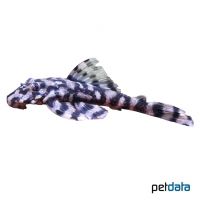Butterfly Pleco (Dekeyseria picta)
| Butterfly Pleco Dekeyseria picta | |
|---|---|
| Name | Butterfly Pleco |
| Name Lat. | Dekeyseria picta |
| Synonym | Dekeyseria brachyura, L52, L168 |
| Family | Suckermouth Armoured Catfishes |
| Family lat. | Loricariidae |
| Order | Catfishes |
| Order lat. | Siluriformes |
| Origin | Brazil, Venezuela |
| Habitat | Streams, rivers |
| Diet | Omnivore |
| pH | 5.5-7.0 |
| Behavior | Nocturnal, peaceful |
| Keeping | Individual, group |
| Care Level | Moderate |
| Reproduction | Cave spawner |
| Breeding | Difficult |
| Life Span | 5-8 years |
| Protection | No |
| Metric Units | |
| Size | 15 cm |
| Temperature | 23-27 °C |
| Hardness | 1-10 °dH |
| Aquarium | ~ 250 l |
| US Units | |
| Size | 6" |
| Temperature | 73-81 °F |
| Hardness | 18-178 ppm |
| Aquarium | ~ 65 gal |
Distribution and habitat
The distribution area of the crepuscular to nocturnal butterfly catfish is the river system of the Rio Negro and the upper Orinoco. They usually stay in the current of rivers and streams, preferably between dead wood and roots that protrude into the water
Maintenance
The aquarium should have a robust planting, with stones, roots and caves (e.g. clay caves) that provide hiding places as well as sufficient free swimming space. A sandy substrate, some subdued light (e.g. floating plants) and a weak current is ideal.
No ammonia, ammonium and nitrite should be detectable, the nitrate value should not exceed 100 mg/l. To ensure the water quality and oxygen content, a filter and heater adapted to the aquarium size is required, as well as lighting for the species-appropriate day-night rhythm of the animals.
Diet
They feed on plant and animal food. For a balanced diet, feed once a day with a high-quality dry food for loricariid catfish (granules, pellets, chips, tablets), supplemented with algae leaves, soft wood and fresh vegetables, such as zucchini, broccoli, bruised peas, scalded spinach, as well as zoopankton, cyclops, daphnia, artemia, mosquito larvae, shrimp, etc. (live or frozen)
Feed only as much as will be eaten within a few minutes, excluding plant foods. Regular and varied feeding promotes health and increases resistance.
Behaviour and compatibility
They should be kept in a group. Harmless ranking fights can occur within the species. Group keeping is only recommended in a larger and richly structured tank. They are very peaceful towards other fish and are well suited for a community tank with South American tetras and cichlids.
Basically, only compatible fish species with similar demands on water condition and water temperature may be socialized.
Sex dimorphism
Sexually mature males have longer odontodes (pointed skin teeth) on the nose and pectoral spines on the first pectoral fin ray, than the female.
Reproduction and breeding
There are isolated reports of successful breeding in the aquarium. The eggs are laid in a cave (cave brooders), often on the side walls or ceiling, and are cared for by the male. After 7-10 days the fry swim free and brood care ends.
Important
They are very variable in their coloration and patterning and can change color. Besides a distinctive night coloration they can also adapt to the underground (chameleon pleco). Therefore they have been scientifically described several times under different names. These names are considered synonyms today, like Dekeyseria brachyura, Peckoltia pulchra, Peckoltia brachyura, Zonancistrus pulcher, Ancistrus pulcher, Dekeyseria pulcher etc. but also the name L52 and L168.
Aquarium plants do not serve them as food, but they can be damaged.
When catching them, use as fine-meshed nets as possible, so that the hard rays of the pectoral fins or the skin teeth (odontodes) do not get caught on the bone plates, which can cause painful puncture wounds when touched.
The well-being of the fish should be checked regularly. Temperature should be checked daily, pH, hardness and nitrate levels at least every 14 days. Regular partial water changes are recommended, even when contaminant levels have not yet reached the upper limit. Sudden changes in water quality should be avoided. Newly introduced fish must be accustomed slowly to the water in the aquarium.
Further literature can be found in your pet store.
References
Text: Werner Winter; Image: petdata
Source: BMELV (1998): Tierschutzgutachten - Haltung von Zierfischen (Süßwasser); ENGELMANN (2005): Zootierhaltung - Tiere in menschlicher Obhut: Fische, Verlag Harri Deutsch; WERNER, LECHNER, SCHMIDT (2005): MiniAtlas L-Welse, Bede Verlag; RIEHL & BAENSCH (2006): Aquarien Atlas Bd. 1, Mergus Verlag
- Gemäß § 21 Abs. 5 Tierschutzgesetz idgF
